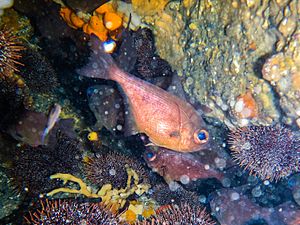New Zealand bigeye facts for kids
Quick facts for kids New Zealand bigeye |
|
|---|---|
 |
|
| Scientific classification |
The New Zealand bigeye (Pempheris adspersa) is a cool type of ray-finned fish that lives in the ocean. It's part of a group called sweepers, from the family Pempheridae. This fish is special because it's only found in the waters around New Zealand.
You can find the New Zealand bigeye living near rocky shores. It loves places with lots of overhangs and hidden cracks or caves. These fish can live anywhere from close to the water's surface down to about 70 meters (230 feet) deep!
Contents
What Does It Look Like?
As its name suggests, the New Zealand bigeye has really large eyes! Its body is quite flat from side to side and has a deep, pointed shape underneath.
The fish is usually dark in color. If you look closely, you'll see it's covered all over with tiny spots. This species can grow up to about 15.8 centimeters (6.2 inches) long. That's about the length of a typical pencil!
Where Does It Live?
The New Zealand bigeye is endemic to New Zealand. This means it's not found naturally anywhere else in the world! Specifically, it lives along the northeastern coast of the North Island of New Zealand.
Life and Habits
The New Zealand bigeye is a nocturnal animal. This means it's most active at night, just like owls or bats!
What Do They Eat?
At night, these fish come out to find food. They mostly eat tiny floating creatures called plankton. They also munch on some small animals that live on the seafloor.
Sometimes, groups of bigeyes will swim far upstream at night. They do this to hunt for tasty treats like shrimp, amphipods (tiny crustaceans), and baby crabs.
Where Do They Hide?
During the day, the New Zealand bigeye needs a safe place to rest. They hide away in cracks, caves, or under rocky ledges and overhangs. These spots keep them safe from predators.
How Do They Communicate?
When these fish come out at night, they actually make sounds! They use a "popping" noise to talk to each other. This helps them stay together in their group, called a shoal.
They have special ways to hear sounds. Their swim bladder (a gas-filled sac that helps them float) and their lateral line (a sensory organ along their side) help them pick up vibrations and sounds in the water.
Reproduction and Young Fish
Female New Zealand bigeyes that are ready to lay eggs have been found from mid-November to February. This is also when they spawn, meaning they release their eggs.
The young fish, called juveniles, start to settle down in their new homes from January to April. You can often find these young bigeyes hiding among the seaweed along rocky shorelines during the late summer in New Zealand.
Sometimes, these fish even swim into estuaries (where rivers meet the sea). They go there to feed on zooplankton among the mangrove forests. They can be found at depths from the surface down to 70 meters (230 feet).

